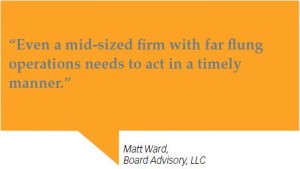Matt Ward’s comments below are excerpted from a Mini-Roundtable on CEO Pay Ratio Disclosure published in the April-June 2014 issue of Risk & Compliance Magazine.
RC: What are the key issues and arguments in the debate over CEO pay disclosure?
 Ward: Probably the biggest challenge is defining who the median employee is and calculating their pay. The rule is deceptively simple at first glance, but implementation can be fraught with complexities depending upon the company. Timing is crucial, and despite what looks like a long lead time, the wise firm would act sooner than later on this issue. Under the proposal, a company would be required to disclose the pay ratio with respect to compensation for its first fiscal year commencing on or after the effective date of the final rule. Companies would be permitted to omit this initial pay ratio disclosure from their filings until the filing of the annual report on Form 10-K for that fiscal year or, if later, the filing of a proxy statement following the end of that year, provided the proxy is filed in a timely manner – within 120 days after the end of the fiscal year. For example, if the final requirements were to become effective in 2014, a calendar-year company would be first required to include pay ratio information relating to compensation for fiscal year 2015 in its proxy statement for its 2016 annual shareholder meeting. Thankfully, the proposal would also provide a transition period for newly public companies. For these companies, initial compliance would be required with respect to compensation for the first fiscal year commencing on or after the date the company becomes subject to the reporting requirements. As a result, pay ratio disclosure would not be required in a registration statement on Form S-1 for an initial public offering or a registration statement on Form 10.
Ward: Probably the biggest challenge is defining who the median employee is and calculating their pay. The rule is deceptively simple at first glance, but implementation can be fraught with complexities depending upon the company. Timing is crucial, and despite what looks like a long lead time, the wise firm would act sooner than later on this issue. Under the proposal, a company would be required to disclose the pay ratio with respect to compensation for its first fiscal year commencing on or after the effective date of the final rule. Companies would be permitted to omit this initial pay ratio disclosure from their filings until the filing of the annual report on Form 10-K for that fiscal year or, if later, the filing of a proxy statement following the end of that year, provided the proxy is filed in a timely manner – within 120 days after the end of the fiscal year. For example, if the final requirements were to become effective in 2014, a calendar-year company would be first required to include pay ratio information relating to compensation for fiscal year 2015 in its proxy statement for its 2016 annual shareholder meeting. Thankfully, the proposal would also provide a transition period for newly public companies. For these companies, initial compliance would be required with respect to compensation for the first fiscal year commencing on or after the date the company becomes subject to the reporting requirements. As a result, pay ratio disclosure would not be required in a registration statement on Form S-1 for an initial public offering or a registration statement on Form 10.
RC: In 2013, the SEC proposed new pay ratio rules, including rules governing the disclosure of CEO compensation. Could you provide a brief outline of these rules, and when companies can expect their implementation?
Ward: Under the proposed rule, the SEC to amend its executive compensation disclosure rules to require disclosure of the ratio of the CEO’s ‘total compensation’, as disclosed in the proxy statement, to the median amount of total compensation for employees of the issuer. Under the proposed rules, all employees of the issuer and its practically all employees of the company must be included in identifying the median employee’s annual total compensation. This includes all full -time, part-time, seasonal or temporary workers employed by the company or any of its subsidiaries “Aside from union pension plans and a small number of other, investors seem to be largely indifferent to the rules.” as of the last day of the company’s prior fiscal year. Despite concern over the compliance costs of including foreign employees in the determination, the proposed rule extends to non-US employees of the company and its subsidiaries. Workers not employed by the company or its subsidiaries, such as consultants or temporary workers employed by a third party, will not be required to be included in the determination. Again, most importantly, the proposed rule will only apply to those employees employed by the company on the last day of the company’s prior fiscal year.
RC: What factors are behind the introduction of these new rules? How have they been received by businesses and investors?
Ward: The rules, promulgated as required by the Dodd-Frank Legislation, took quite a while to come about. The SEC likely had hoped that the legislation would be repealed or amended. The pay ratio provision of the legislation came about from a longstanding criticism that CEO pay in the US was unreasonably high as a multiple of employees, especially when compared with other countries’ practices. Critics used to cite Japan as an example of successful and powerful companies that managed to keep pay of the CEO at a much lower multiple of the typical worker. However, savvy observers pointed out that indirect CEO pay at Japanese companies such as numerous servants, private jets and mansions around the world was not measurable and quite considerable. Despite this, the criticism was a regular part of annual executive pay disclosure cycles ever since. After the financial collapse of 2008, the groundswell of support for anti-CEO pay legislation was unstoppable. It is safe to say that, like the SEC, businesses and investors had hoped that the legislation would be repealed or amended, but so far no such luck.

RC: What steps can firms take to prepare for the proposed rules? What guidance has the SEC provided?
Ward: We think that companies should not procrastinate on this issue and should at least run some initial calculations now to get ahead of the curve on choosing a methodology. While it is obvious for very large multinationals to address this, even a mid-sized firm with far flung operations needs to act in a timely manner. In fact, it is the small to mid-size firms that could be blindsided by waiting too long to address this calculation.
RC: In determining pay ratios, companies must first determine the salary of the ‘median employee’. What methods can firms use to determine this value? What sampling methods have been approved by the SEC?
Ward: The SEC permits public companies to select a methodology for identifying the median employee under the proposed rule. The proposed rule does not set forth a methodology that must be used to identify the median employee and permits companies the ability to select the method that works best for their own facts and circumstances. For example, the company could identify the median by calculating the total compensation per employee under existing executive compensation rules or through a statistical sampling of its employee population. To address commenter concerns about the compliance costs of calculating total compensation per employee under existing executive compensation rules, the SEC will also permit the usage of a ‘consistently applied compensation measure’ in identifying the median. For example, companies could identify a median employee by using more readily available methods such as total direct compensation – such as annual salary, hourly wages or other performance-based pay – or cash compensation and then calculate that median employee’s total compensation in accordance with executive compensation rules. Compensation for a permanent employee who did not work a full year – such as a new hire or an employee who took an unpaid leave of absence – would be permitted but not required to be annualized. However, the company would not be permitted to annualized compensation for temporary or seasonal workers. The company would be given the flexibility to measure compensation by choosing a method that best reflects the way it pays its employees, as long as that method is consistently applied.
RC: What impact do you believe the new rules will have on business practices, particularly in terms of structuring compensation packages? Do you expect the rules to significantly impact levels of executive pay?
Ward: We don’t believe the rules will have any meaningful impact whatsoever on pay levels for CEOs or median workers. The flexibility for companies in choosing methodologies and determining the median employee’s pay essentially renders peer-to-peer comparisons useless, even in industries with very close comparability of firms, such as oil companies, airlines, and so on. When coupled with the cost to comply, hopefully there will eventually be support for repealing the legislation. We have had clients estimate they will need to add full-time equivalent employees just to gather this data.
RC: What final advice can you offer to companies on the proactive steps required to address the issue of CEO pay ratio disclosure in today’s business world?
Ward: The SEC has provided great flexibility in applying the proposed new rules in each specific company. However, there are still going to be data collection issues and meaningful choices to be made in carrying out the calculations and choosing a methodology. We recommend that companies exercise the due diligence up front to form a task force of accounting and compensation professionals from both inside and outside the company to make the most well-informed choices. Thereafter, the annual calculation will be much easier and subject to change only to comply with rule changes or industry trends in making the calculation.
For a full copy of the article, download here: R&C CEO PAY RATIO DISCLOSURE